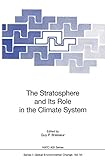The stratosphere and its role in the climate system Libro electrónico editor: Guy P. Brasseur
Tipo de material: Libro
en línea Idioma: Inglés Series Detalles de publicación: New York, New York, United State Springer c1997Descripción: xx, 365 páginas ilustraciones 24 centímetrosISBN:
Libro
en línea Idioma: Inglés Series Detalles de publicación: New York, New York, United State Springer c1997Descripción: xx, 365 páginas ilustraciones 24 centímetrosISBN: - 3540634746
- 9783642083341 (Print)
- 9783662033272 (Online)
- Disponible en línea
Incluye bibliografía
Chapter 1. Introduction.. 1. Introduction.. Chapter 2. Dynamics.. 2. Atmospheric dynamics: fundamentals.. 3. Zonally averaged flow.. 4. Influence of the "tropical pump" on trace constituents and temperature.. 5. Wave-mean-flow interactions.. 6. Observations of dynamical processes.. 7. Influences of the solar cycle on climate through stratospheric processes.. Chapter 3. Radiation.. 8. Radiative transfer in troposphere-stratosphere global climate models.. 9. Satellite remote sensing: the retrieval problem.. 10. UV-B radiation and its effects on the biosphere.. 11. Radiative forcing.. Chapter 4. Chemistry.. 12. Chemistry of the atmosphere.. 13. Chemical families.. 14. Mid-latitude ozone depletion.. 15. Polar ozone.. 16. Observations of chemical composition.. 17. Laboratory kinetics.. 18. Formulation of a chemical transport model.. 19. Remote sensing of stratospheric aerosols, clouds and gases.. 20. The upper atmosphere research satellite (UARS.. Bibliography
Disponible para usuarios de ECOSUR con su clave de acceso
This book presents a summary of the lectures given at the NATO Advanced Science Institute (ASI) which took place at Val Morin, Quebec, Canada, 4-15 September, 1995. This summer school offered an excellent opportunity to discuss key scientific questions related to the stratosphere and its importance for the climate system. Approximately 85 students and 15 lecturers from 19 nations attended the ASI which was sponsored by SPARC (Stratospheric Processes and Their Role in Climate), a project of the World Climate Research Programme. The purpose of the ASI was to present truly tutorial lectures rather than highly specialized or technical talks. At the conference, mornings were devoted to fundamental presentations while short illustrative talks were given in the afternoon. The book presents a summary of the two types of lectures. We were fortunate to enlist the participation of outstanding experts in the field of atmospheric science and excellent teachers. Students were strongly encouraged to actively participate in various activities during the summer school; for example, the students were asked to summarize the lectures given by the teachers, and in most cases, the chapters presented in this book were written by small groups of students and reviewed by the lecturers. During the school, students had also the opportunity to present posters that described their personal research. These lecture notes are divided into three major parts. Inglés
Disponible en línea
Disponible en formato PDF


